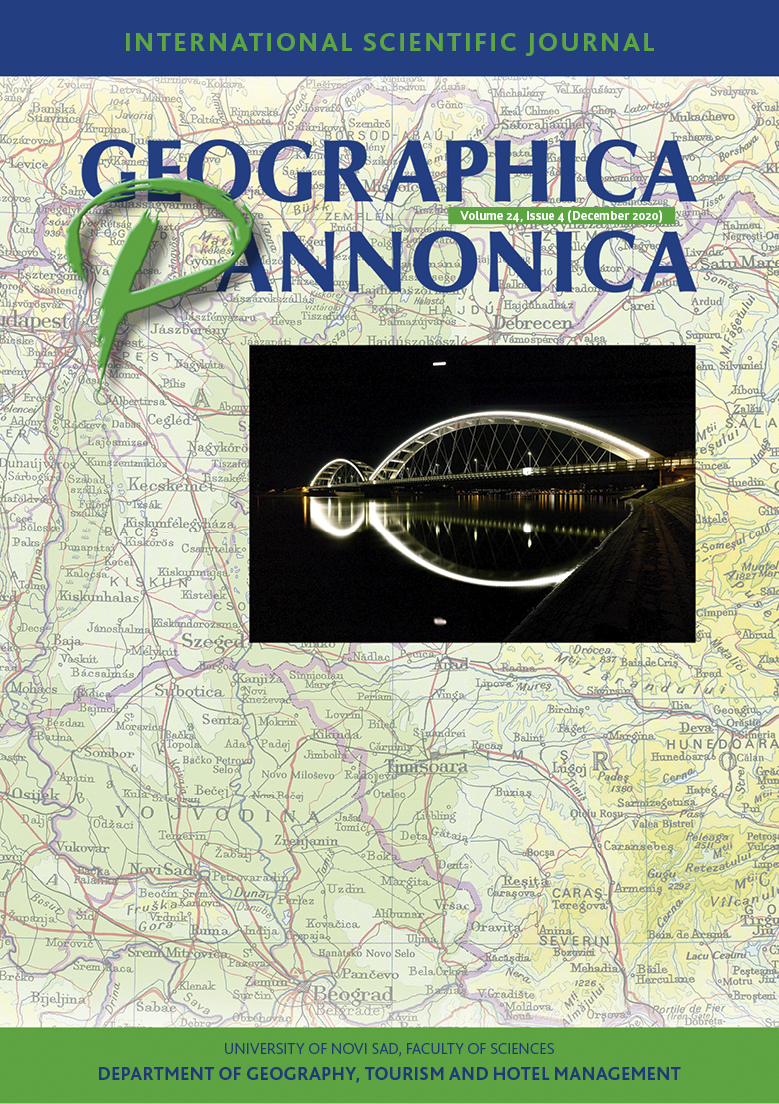Evaluation of Outdoor Thermal Comfort Conditions in Northern Russia over 30-year Period (Arkhangelsk Region)
Abstract
The aim of the current paper is to evaluate spatial and temporal characteristics of the distribution of bioclimatic comfort within the Arkhangelsk region (Russian Federation) with two modern indices of thermal comfort: PET and UTCI. Its average values calculated for the modern climatic period (1981-2010) in the monthly mean give a clear picture of spatial heterogeneity for the warmest month (July) and for the coldest one (January). The spatial picture of both indices in July allows us to distinguish three large internal regions: the Arkhangelsk province, the continental part of the Nenets Autonomous Okrug (NAO) and Novaya Zemlya islands (NZ). Winter distribution of thermal discomfort is fundamentally different: the coldest regions (with extreme cold stress) are equally NZ and the eastern half of NAO; intermediate position is occupied by the west of the NAO and the extreme north-east of the Arkhangelsk region, the highest winter UTCI values are observed in the rest of the region. In Archangelsk-city extreme cold stress in January has repeatability 6.7%, in February - 4%, in December - 2.2%, respectively. The average number of time points during the year at which thermal stress is not observed is only 19%. Obtained results will be the basis for planning relevant health measures and providing reliable forecasts of the effects of climate change in the Arctic region.
References
Bauche, J. P., Grigorieva, E. A., & Matzarakis, A. (2013). Human-biometeorological assessment of urban structures in extreme climate conditions: The example of birobidzhan, Russian far east. Advances in Meteorology, 2013. https://doi.org/10.1155/2013/749270
Dee, D. P., Uppala, S. M., Simmons, A. J., Berrisford, P., Poli, P., Kobayashi, S., … Vitart, F. (2011). The ERA-Interim reanalysis: Configuration and performance of the data assimilation system. Quarterly Journal of the Royal Meteorological Society, 137(656), 553–597. https://doi.org/10.1002/qj.828
Gommershtadt, O., Konstantinov, P., Varentsov, M., & Baklanov, A. (2020). Modeling Technology for Assessment of Summer Thermal Comfort Conditions of Arctic City on Microscale: Application for City of Apatity. In Springer Geography (pp. 66–75). https://doi.org/10.1007/978-3-030-16091-3_10
Havenith, G., Fiala, D., Błazejczyk, K., Richards, M., Bröde, P., Holmér, I., … Jendritzky, G. (2012). The UTCI-clothing model. International Journal of Biometeorology, 56(3), 461–470. https://doi.org/10.1007/s00484-011-0451-4
Höppe, P. (2002). Different aspects of assessing indoor and outdoor thermal comfort. Energy and Buildings. https://doi.org/10.1016/S0378-7788(02)00017-8
Jendritzky, G., de Dear, R., & Havenith, G. (2012). UTCI-Why another thermal index? International Journal of Biometeorology, 56(3), 421–428. https://doi.org/10.1007/s00484-011-0513-7
Konstantinov, P. I., Grishchenko, M. Y., & Varentsov, M. I. (2015). Mapping urban heat islands of arctic cities using combined data on field measurements and satellite images based on the example of the city of Apatity (Murmansk Oblast). Izvestiya - Atmospheric and Ocean Physics, 51(9), 992–998. https://doi.org/10.1134/S000143381509011X
Lin, T. P., & Matzarakis, A. (2011). Tourism climate information based on human thermal perception in Taiwan and Eastern China. Tourism Management. https://doi.org/10.1016/j.tourman.2010.03.017
Lopes, A., Lopes, S., Matzarakis, A., & Alcoforado, M. J. (2011). The influence of the summer sea breeze on thermal comfort in funchal (Madeira). A contribution to tourism and urban planning. Meteorologische Zeitschrift, 20(5), 553–564. https://doi.org/10.1127/0941-2948/2011/0248
Matzarakis A.;Mayer H. (1996). Another kind of environmental stress. Thermal stress. WHO News 18:7–10.
Matzarakis, A., Mayer, H., & Iziomon, M. G. (1999). Applications of a universal thermal index: Physiological equivalent temperature. International Journal of Biometeorology, 43(2), 76–84. https://doi.org/10.1007/s004840050119
Matzarakis, A., & Nastos, P. T. (2011). Human-biometeorological assessment of heat waves in Athens. Theoretical and Applied Climatology, 105(1), 99–106. https://doi.org/10.1007/s00704-010-0379-3
Matzarakis, A., Rutz, F., & Mayer, H. (2010). Modelling radiation fluxes in simple and complex environments: basics of the RayMan model. International Journal of Biometeorology, 54(2), 131–139. https://doi.org/10.1007/s00484-009-0261-0
Mayer, H., & Höppe, P. (1987). Thermal comfort of man in different urban environments. Theoretical and Applied Climatology, 38(1), 43–49. https://doi.org/10.1007/BF00866252
Muthers, S., Matzarakis, A., & Koch, E. (2010). Summer climate and mortality in Vienna - A human-biometeorological approach of heat-related mortality during the heat waves in 2003. Wiener Klinische Wochenschrift, 122(17–18), 525–531. https://doi.org/10.1007/s00508-010-1424-z
Shartova, N. V., Shaposhnikov, D. A., Konstantinov, P. I., & Revich, B. A. (2019). AIR TEMPERATURE AND MORTALITY: HEAT THRESHOLDS AND POPULATION VULNERABILITY STUDY IN ROSTOV-ON-DON. Fundamental and Applied Climatology, 2, 66–94. https://doi.org/10.21513/2410-8758-2019-2-66-94
Streletskiy, D., Shiklomanov, N., & Nelson, F. (2012). Permafrost, infrastructure, and climate change: A gis-based landscape approach to geotechnical modeling. Arctic, Antarctic, and Alpine Research, 44(3), 368–380. https://doi.org/10.1657/1938-4246-44.3.368
Varentsov, M., Konstantinov, P., Baklanov, A., Esau, I., Miles, V., & Davy, R. (2018). Anthropogenic and natural drivers of a strong winter urban heat island in a typical Arctic city. Atmospheric Chemistry and Physics, 18(23), 17573–17587. https://doi.org/10.5194/acp-18-17573-2018
Weihs, P., Staiger, H., Tinz, B., Batchvarova, E., Rieder, H., Vuilleumier, L., … Jendritzky, G. (2012). The uncertainty of UTCI due to uncertainties in the determination of radiation fluxes derived from measured and observed meteorological data. International Journal of Biometeorology, 56(3), 537–555. https://doi.org/10.1007/s00484-011-0416-7
Internet 1: Climate and weather of Russia http://www.pogodaiklimat.ru/climate/22550.htm (2019.12.02.)

